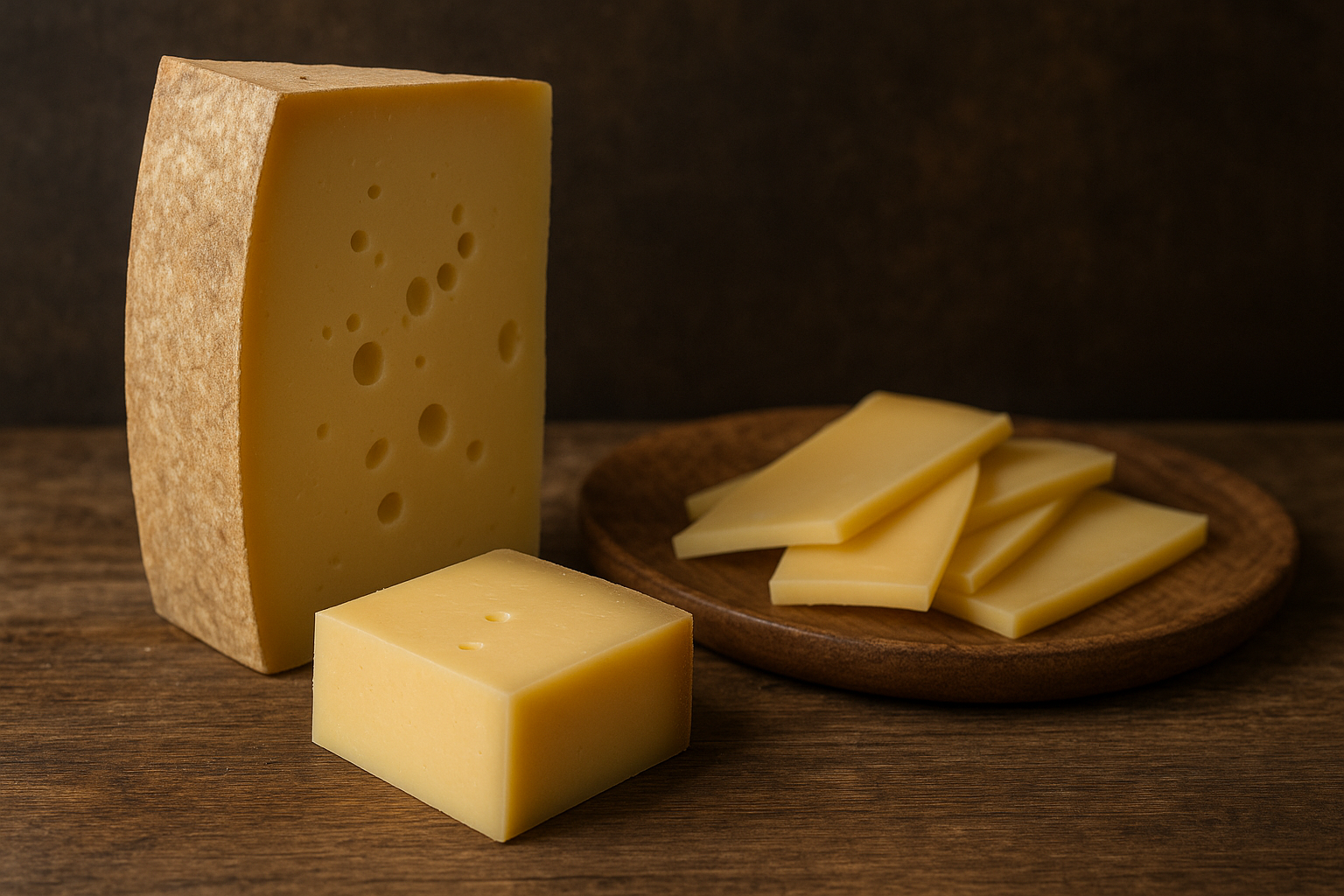Gruyère cheese is one of those remarkable ingredients that quietly transforms any dish it touches. Originating from Switzerland, this smooth, firm cheese is celebrated for its balance of nutty sweetness and savory depth. It’s a favorite in both rustic family recipes and fine dining because it melts with grace, infusing dishes with a rounded richness that’s hard to match. Think of Gruyère as both a comfort and a culinary tool — versatile, refined, and wonderfully timeless.
A true Gruyère has a golden rind with a pale, creamy interior. Beneath that simple surface lies centuries of tradition and natural artistry. Its flavor develops with age, evolving from mild and creamy to strong and earthy. Beyond its world-famous role in fondue, Gruyère cheese finds a place in gratins, sandwiches, soups, and even baked dishes where subtlety and sophistication matter.
The Origins and Heritage of Gruyère Cheese
The story of Gruyère cheese begins in western Switzerland, in the lush region around the town of Gruyères. Cheesemaking in this Alpine area dates back to at least the 12th century. Shepherds working in mountain pastures would collect rich cow’s milk and craft wheels of cheese designed to last through harsh winters — sturdy, hearty, and full of nutrition.
Over time, these early cheeses evolved into what we now recognize as Gruyère. Traditional methods remain largely unchanged: milk from cows grazing on natural mountain grasses, gentle heating in copper vats, and careful aging in cool stone cellars. The Swiss environment — clean air, mineral-rich soil, and diverse mountain pastures — gives the cheese its uniquely balanced flavor. Each wheel of Gruyère silently tells the story of its origin, shaped by nature and tradition in equal measure.
What Makes Gruyère Cheese Unique?
Gruyère stands out because it manages to be both delicate and bold. Its texture is firm yet supple, with small holes scattered throughout the paste. The flavor starts sweet and creamy when young and develops a more pronounced nuttiness and subtle saltiness as it matures. Aged Gruyère, sometimes aged for up to a year or more, reveals a complex bouquet — an interplay of toasted nuts, caramel, and dried fruit notes.
People often confuse Gruyère cheese with other European alpine cheeses such as Emmental or Comté. While they share a family resemblance, Gruyère is generally denser and more robust in taste. Emmental tends to be milder with larger holes, whereas Gruyère’s flavor is deeper and more cohesive. This complexity is what makes it so reliable in cooking — you get richness without overpowering the other ingredients.
Aging plays an essential role, too. Younger varieties, called “doux,” have a milder and creamier flavor. Mature ones, referred to as “salé” or “réserve,” exhibit depth, firmness, and the faint graininess that gourmets adore. This maturation process defines the balance between texture and taste, turning Gruyère cheese into a living expression of time and craftsmanship.
How Gruyère Cheese Is Made?
The making of Gruyère cheese is both artisanal and precise. It starts with fresh, unpasteurized cow’s milk — often gathered daily from local farms. Cheesemakers gently warm the milk in traditional copper vats and add natural cultures and rennet to begin the curdling process. Once the curds form, they’re cut into small grains and heated slowly, allowing them to release whey.
The curds are then pressed into large molds to form the characteristic round wheels, each weighing about 35 kilograms. Every wheel is immersed in a brine bath, which seasons the cheese and encourages rind development. After salting, aging begins — sometimes lasting up to 18 months. During this period, wheels are turned regularly and carefully brushed to ensure even texture and rich character.
It’s a process that depends on patience and skill more than modern machinery. Every step — from the temperature of the vat to the humidity of the aging cave — matters. The result is a cheese that’s consistent in quality but never uniform, each batch reflecting minute differences in milk, weather, and region.
Culinary Uses and Pairings
Gruyère cheese is famously versatile in the kitchen. Its smooth melting ability makes it the backbone of traditional Swiss fondue, combining beautifully with white wine and other mountain cheeses. In France, it’s indispensable in a croque monsieur or sprinkled over onion soup, lending that golden, bubbling top layer everyone loves.
But Gruyère’s talents go beyond melting. It can elevate everyday dishes — think mashed potatoes enriched with a handful of grated Gruyère, or a quiche where its nutty warmth anchors the custard. It’s equally delightful served cold, sliced thin with fresh fruit or nuts.
For pairings, Gruyère complements both simple and refined flavors. It pairs effortlessly with medium-bodied wines like Pinot Noir or dry white wines such as Sauvignon Blanc. The cheese’s balance of sweetness and saltiness also makes it shine alongside apples, pears, and crusty artisanal bread. Each pairing reveals another side of Gruyère — a cheese that’s as adaptable as it is elegant.
Nutritional Profile and Benefits
Beyond taste, Gruyère cheese brings meaningful nutrition to the table. It’s rich in high-quality protein, essential for muscle building and energy. A modest serving provides a strong dose of calcium, vital for bone health, along with phosphorus and vitamin B12. Gruyère also contains natural fats that help create satiety — making it satisfying even in small portions.
Despite its density, Gruyère fits comfortably into a balanced diet when enjoyed in moderation. Its full flavor means you can use less to achieve the same culinary effect. In contrast to heavily processed cheeses, traditional Gruyère is crafted from simple ingredients: milk, cultures, salt, and time. That authenticity not only enhances flavor but also aligns with modern preferences for naturally made foods.
How to Choose, Store, and Serve Gruyère Cheese?
When buying Gruyère cheese, authenticity matters. Look for the AOP (Appellation d’Origine Protégée) label, which ensures the cheese comes from one of the official Swiss regions of production and meets strict quality standards. Genuine Gruyère will have a firm rind with a subtle scent of wood and nuts.
To store Gruyère, wrap it in waxed paper or breathable cheese paper rather than plastic. This preserves its natural moisture while preventing spoilage. Keep it in the refrigerator’s cheese drawer, ideally around 8–10°C, where the temperature remains stable.
When ready to serve, bring the cheese to room temperature for about half an hour. This allows the full aroma and flavor to emerge. A well-cut wedge of Gruyère, with its golden tint and smooth finish, needs little adornment. Slice it thinly for tasting or grate it finely when adding to warm dishes so it melts evenly.
Regional Varieties and Modern Interpretations
Gruyère cheese has maintained its traditional identity while allowing room for regional nuance. The AOP designation protects only those varieties made in specific Swiss cantons, such as Fribourg and Vaud, ensuring compliance with time-honored methods. Slight differences in mountain altitude, local grass species, and moisture levels make each wheel distinct.
Modern cheesemakers and chefs have also taken inspiration from Gruyère’s qualities. Some produce small-batch artisan versions with subtle tweaks — longer aging, different brining methods, or organic milk from single herds. Restaurants around the world use Gruyère creatively, folding it into pastries, sauces, and even desserts that play with its sweet-savory duality.
This adaptability across cultures and cuisines proves its universal appeal. Whether enjoyed in a centuries-old chalet or a contemporary kitchen, Gruyère continues to evolve while honoring its roots.
Conclusion: The Enduring Appeal of Gruyère Cheese
Gruyère cheese is more than an ingredient — it’s an experience that combines history, flavor, and craftsmanship in each bite. Its journey from the Alpine meadows to modern kitchens shows the staying power of tradition perfected over time. Through its nutty aroma, velvety texture, and unmatched melting qualities, Gruyère has earned its place as a cornerstone of European cheesemaking.
From bubbling fondues and golden gratins to refined tasting boards, this Swiss treasure always delivers warmth and depth. It’s not just about taste; it’s about connection — to heritage, to quality, and to the simple pleasure of real food. The enduring appeal of Gruyère cheese lies in its ability to bridge worlds: rustic yet refined, regional yet universal, timeless yet ever-new.
My name is Mustafa, and I have been blogging for over 5 years. I am passionate about sharing complete, accurate, and helpful information with my readers. Along with managing content on The Matcha Read, I also contribute blog posts to premium websites. My goal is to provide valuable insights in a clear and easy-to-understand way, so every reader walks away with useful knowledge.










